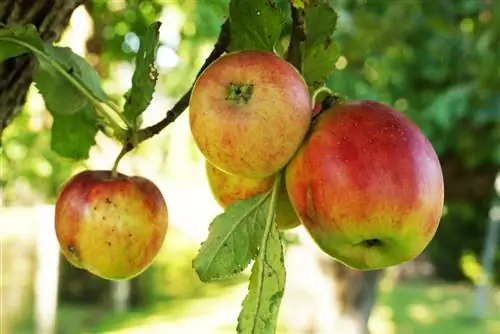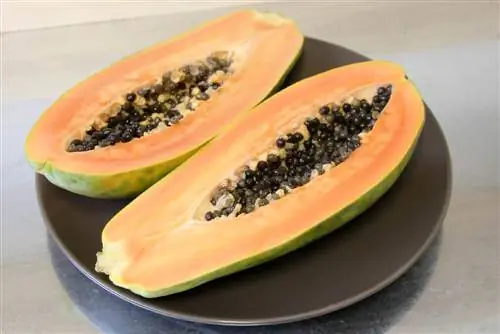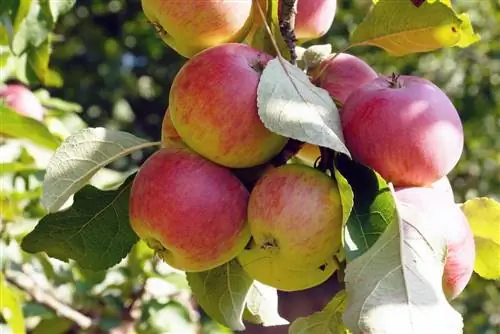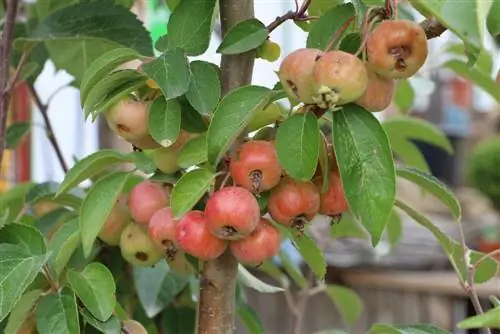- Author admin [email protected].
- Public 2023-12-17 03:39.
- Last modified 2025-06-01 06:48.
If you plant an apple tree (Malus), you need a little patience. It takes about ten years from the apple core to the first harvest. However, growing a plant from an apple core is so time-consuming that hobby gardeners usually purchase a tree from a dealer. Fruit trees are often offered bare-root, i.e. without root balls, with a height of around 80 centimeters. Larger trees with a height of around 120 centimeters can be purchased with pronounced roots in a container.
How an apple tree grows
Observe the correct planting height of the apple tree. At the base of the trunk there is a thickening, the grafting point. This must be about 10 centimeters above the ground and must not be covered with soil. Otherwise it can happen that the tree forms roots above the grafting point.
Growth factors
How fast an apple tree grows depends on several factors:
- Growth habit and grafting rootstock
- Location and care
- Cut
Growth forms
Depending on the variety and location, apple trees grow around 30 centimeters per year. Apple trees are available as bushes, spindles, half-stems or standard trees. This classification determines what size the tree can reach.
bush tree
Bush trees are grafted onto a base that reduces root growth by around 50 percent.
- Trunk height: about 60 centimeters
- Final height: 3 to 4 meters
Spindle tree
Spindle trees are suitable for small gardens. They are refined on a base that reduces root growth and thus also stability. Spindle trees must therefore be tied to a post.
- Trunk height: 60 centimeters
- Final height: 2 to 3.5 meters
Half trunk
Half-trunks form strong roots and are characterized by vigorous growth.
- Trunk height: 120 to 160 centimeters
- Final height: 4 to 6 meters
High trunk
High trunks represent the original form of the apple tree. They promise a rich harvest.
- Trunk height: 160 to 200 centimeters
- Final height: 6 to 8 meters
Location and care
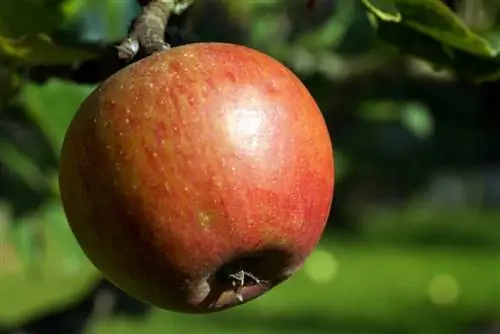
Depending on the variety and growth habit, apple trees require a lot of space in the garden. As mature trees, tall trunks require a space of up to 10 meters. Caring for apple trees does not require much effort. However, good development can be supported by appropriate measures:
Pouring
- water abundantly in dry months - reduce drying out with a layer of mulch
- Remove weeds from the tree slice, do not plant them
Fertilize
- do not fertilize young trees in the first year after planting
- add compost regularly later
Winter protection
- Lime paint to increase the elasticity and resistance of the tree bark
- Dates: November and February
Cut
Apple trees need to be pruned at least once a year for optimal growth and a good harvest. Failure to prune will lead to the tree becoming bald and sooner or later to loss of yields. When cutting, a distinction is made between planting cuts, training cuts and maintenance cuts.
1. Plant cutting:
- takes place immediately after planting
- Removing all upward shoots that compete with the main shoot
- only the main shoot and 3 to 4 side shoots (leading branches) remain
2. Parenting cut
- from the second year in February to support crown formation
- Short the main and side shoots by around 30 percent
- Target: 6 to 8 side branches per leading branch
3. Conservation cut
- carry out annually in summer when the crown has developed well
- Removing dry and weak branches
- cutting straight water bullets
- remove branches growing inwards
Tip:
Take a look at your apple tree from afar. The maintenance pruning should also lead to the development of a beautiful crown shape. Remove any branches that grow vertically upwards. These so-called water projectiles cost a lot of energy and reduce the crop yield.
Variety and growth
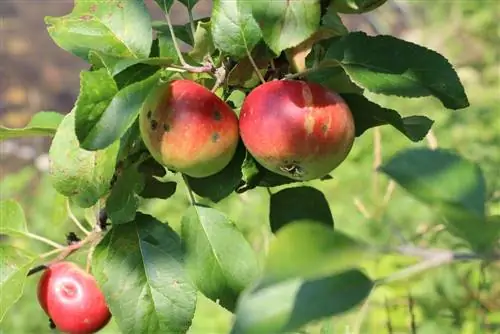
The variety has less influence on the rate of growth than many hobby gardeners think. On average, malus grow around 30 centimeters per year. The grafting base, which determines the growth of the roots, has a major influence.
The following are considered strong-growing varieties:
- Boskoop 30 to 45 centimeters/year
- Elstar 30 to 50 centimeters/year
- Gloster 30 to 50 centimeters/year
- Gravensteiner 30 to 50 centimeters/year
- Hornburger pancake apple 30 to 50 centimeters/year
- James Grieve 30 to 40 centimeters/year
Medium-growing varieties are:
- Alkmene 20 to 40 centimeters/year
- Jonagold 20 to 40 centimeters/year
- red star reindeer 20 to 30 centimeters/year
- White clear apple 20 to 40 centimeters/year
The following are considered weak-growing varieties:
- Rondo columnar apple 10 to 20 centimeters/year
- Pillar Apple Sonata 5 to 10 centimeters/year
- Dwarf Apple Croquella 5 to 20 centimeters/year
Disadvantages of growth
At first, hobby gardeners are happy when a young apple tree grows in size. Mature tall stems require a lot of space and can no longer be harvested without ladders. This effort should be taken into account when planting. If you're afraid of the effort, you should opt for small half-trunks or espaliered fruit. Nevertheless, a big old apple tree has a special charisma.

